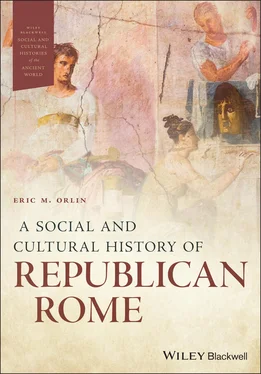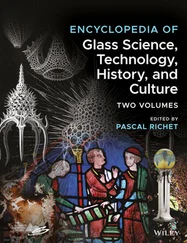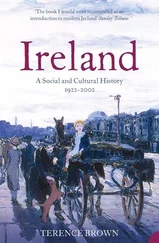This book is therefore organized thematically after the first two chapters that offer a chronological introduction. These thematic chapters generally employ a two-part structure. The first part of the chapter attempts to identify the key elements of Roman practices in each area, and the second half tries to understand the impact of Roman conquest on that particular area of life. Some readers or instructors may prefer to operate thematically and make connections across the chapters, and the book tries to offer frequent call-backs to assist with these connections. Others may prefer to read the first half of related chapters (for instance on the family and sex/gender) together and then read the second halves of these chapters, to better see how the changes in family life connect to changes in sex/gender behavior. Readers are invited to use the book in whatever way is most useful to them.
A final note. Since the book lacks a formal conclusion, the last two paragraphs of the final chapter might be seen as a conclusion, not just to that chapter, but to the entire work. They pose the question whether the Roman adoption of practices from other cultures should be viewed in a positive light, as an openness to cultural exchange with others, or in a negative light, as appropriation of another culture. Readers might ask themselves the same question about our own adoption of Roman practices. The answers may vary from practice to practice, and from person to person. Good historians raise their own questions and come to their own conclusions.
1 What Is Historical Thinking?
The Roman historian Livy(Titus Livius, 59 BCE–17 CE) offers the following narrative about the life of Romulus, the founder of Rome. Rhea Silvia was made a Vestal Virgin in the hopes of preventing her from having children; she became pregnant, by the god Mars according to her account. When she gave birth to the twins Romulus and Remus, the king ordered the babies to be exposed by the Tiber River, but they were miraculously nourished by a she-wolf and then discovered by a farmer (Figure 1.1).

Figure 1.1 Bronze statue of a she-wolf suckling Romulus and Remus. Musei Capitolini, Rome. The wolf was originally considered to be Etruscan, but is now thought to date to the tenth century CE. The twins definitely date to the fifteenth century CE.
After they grew up, they overthrew their evil grandfather and decided to found a new city on the spot where they had been exposed, but the brothers could not agree who should be the ruler of the new city. They decided to hold a contest by looking out for birds; Remus saw six, but a moment later Romulus saw twelve. The conflicting result led to an argument in which Remus was killed. Romulus then offered his new settlement as a place of refuge for fugitives and other dispossessed people. His men then kidnaped women from a neighboring community in order to get wives, and the city prospered. Finally, one day as Romulus was reviewing the Roman army, a sudden thunderstorm arose, with clouds so thick that no one could see him and “from that moment Romulus was no longer seen on earth.” A few men took the initiative and began to say that Romulus had been swept up into the heavens and soon the entire people were calling Romulus a god and the son of a god and praying that he might forever protect his children, the people of Rome. However, even then, says Livy, there were some who quietly claimed that the king had been torn to pieces at the hands of the senators (Bk. 1, Ch. 3–16).
Few historians today would accept the details of these stories, and fewer still would be willing to stake their reputation even on Romulus being a historical person, but these stories are still the place where we must start our work of understanding the Romans. At the very least, they represent the stories that the Romans themselves told about the foundation of their city. As historians, we can only work with the material that we have; we cannot create stories out of thin air, but parts of the narrative – the she-wolf nourishing infant twins, the ascension of Romulus into heaven – seem too fanciful to believe. Sometimes we can use our common sense to decide what to accept, but sometimes our assumptions about what is possible are not reliable. The story of Romulus’ ascension may seem unbelievable, but the story of Jesus’ ascension into heaven has billions of believers around the world, and in principle is no different from Romulus. So how do we, as people living twenty centuries or more after the Romans, handle these stories? That is our task as practitioners of historical thinking.
The most important element to understand about a historical source is not its date, or the identity of its author, or the bias of the author, although those are all important. It is understanding what the author is trying to do and what their purpose is in writing . The first question we should ask about Livy’s account is: what is he trying to accomplish with these stories about Romulus?
Fortunately, Livy, like most ancient and many modern historians, reveals his purpose at the very beginning of his text. He indicates that he will concern himself with:
the life and morals of the community; the men and the qualities by which through domestic policy and foreign war dominion was won and extended… so that you see, set in the clear light of historical truth, examples of every possible type. From these you may select for yourself and your country what to imitate, and also what, being disgraceful in its origin and disgraceful in its conclusion, you are to avoid (Livy, Preface ).
How might the knowledge that Livy wants to use Romulus to suggest something of the “life and morals of the community” help us understand his stories? For one it helps make sense both of the she-wolf story and of Romulus becoming a god. Livy wants us to know that the Romans viewed Romulus as someone so special that he must have had a direct link to divinity. Ancient texts are full of stories of the miraculous rescue of infants exposed to a premature death: Oedipus from Greek mythology or Moses from the Bible are similar examples. All of these stories are meant to tell the reader that an individual was destined for greatness, and in some way connected to the divine. If we read the story as Livy’s attempt to make us understand the greatness of Romulus rather than as a literal description of facts, the text becomes more understandable.
We can go further with our analysis. In the story about the death of Remus, the brother of Romulus, Livy actually offers two versions. He first describes how Romulus and Remus engaged in a battle of words over the founding of the city: the verbal fighting led to physical fighting where Remus was killed. But Livy goes on to tell another version in which Remus leaped over the walls of the new city as a way to mock his brother, leading his brother to strike him dead with the words “So perish all who leap over my walls!” Livy here makes the morals of Rome’s founder clear: Romulus placed the honor and protection of the city above the ties of family, a character trait that reappears frequently in episodes from Roman history. It might be seen as a part of Roman morality. However, we have to grapple with the fact that Livy tells us two stories, and seems to tell us this second story only because it was “more frequently told.” Did Livy not believe the second story? Does he want us not to believe it? Is the lesson really that Rome’s founder placed civic ties above family ties, or was it that he killed his brother out of anger? Perhaps Romulus is not an example to be imitated after all, but an example to be avoided. Note that once we know that Livy wants us to draw moral lessons from Roman history, we can start asking different questions rather than asking whether it really happened that way.
Читать дальше













